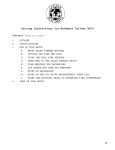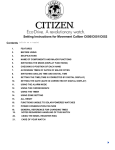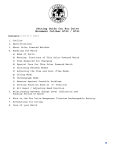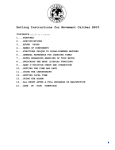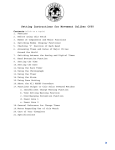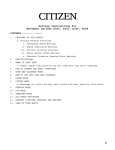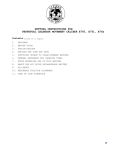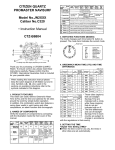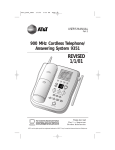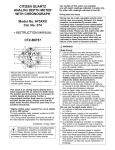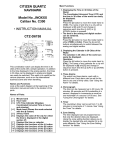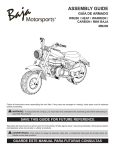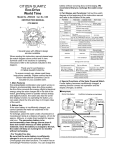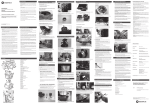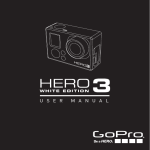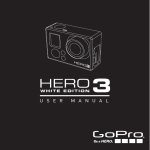Download Citizen E100 User's Manual
Transcript
Setting Instructions for Movement Caliber E100 Contents (click on a topic) 1. 2. 3. 4. 5. 6. 7. 8. 9. Outline Specifications About Solar Powered Watches Setting the Time and Calendar Functions of the Solar Power Watch Time Required for Recharge Notes on Recharging About the Eco Drive Rechargeable Battery Care of Your Timepiece Return to Table of Contents 1.OUTLINE This watch is an analog solar powered timepiece that has a solar cell on its dial that converts the light into electrical energy to drive the movement. 2. Specifications Accuracy E100 Within +/- 15 seconds per month (when worn at normal temperatures of 5oC to 35 oC/(41oF to 95 oF) Operating temperature range Display Time function Calendar Hour, Minute, Seconds Movement Caliber Number Additional Functions Continuous operating times Day and Date • Quick Start Feature • Insufficient charge warning function • Time setting warning function • Overcharging Prevention Function Fully charged to stopped: Approximately 6 months From insufficient charge warning to stop Approximately 1 week Battery Eco Drive rechargeable Manganese Titanium battery. Not user replaceable 3. SOLAR POWER WATCH This watch is powered not by an ordinary battery, but by converting light energy into electrical energy. A rechargeable battery is used in this watch to store electrical energy. This secondary battery is a clean energy battery that doesn't use any toxic substances such as mercury. Once fully charged, the watch will continue to run for approximately 6 months without further charging. • • • • Since the energy source of this watch is light, expose it to light sufficiently to charge the battery in it. The battery of this watch is never overcharged by exposing it to light. If the user wears long-sleeved clothes usually, the watch is covered and its rechargeable battery may not be charged sufficiently. If so, additional charging may be necessary when not worn. The watch should be put on a well-lit place as long as possible for its normal operation while it is not worn. The watch should be exposed to light each day to ensure the watch has a sufficient charge for proper operation. Return to Table of Contents Return to Table of Contents 4. Setting the Time and Calendar If your watch has a screw-type crown, unscrew the crown from the case loosen it before operation. Be sure to press the crown down and screw in after setting the time and/or date. <Setting the time> 1. 2. 3. Stop the second hand by pulling the crown out to the 2nd click (time setting position). Turn the crown to set the time. The watch will start after the crown is firmly pushed back into its normal position. <Setting the calendar> 1. 2. 3. 4. Pull the crown out to the first click (calendar setting position). Set the desired date by turning the crown counterclockwise. Set the desired day of the week by turning the crown clockwise. After you have set the calendar, be sure to press the crown back to its normal position. Do not adjust the calendar when the watch is reading between 9:00 pm and 4:00 am. Otherwise the movement may become damaged and the calendar may not change correctly. Return to Table of Contents Return to Table of Contents 5. Functions of the Solar Power Watch If the charge becomes insufficient, a warning function will operate and the display changes, as below. • Insufficient Charge Warning Function The second hand changes to two-secondinterval movement to indicate insufficient recharging. Even in such a case, the watch keeps correct time, but about 1 week after twosecond-interval movement begins, the watch will stop. After exposing the watch to light, recharging takes place and the watch returns to one-second-interval movement. • Quick Start Function The watch will stop if it is completely discharged. It will begin to operate soon after (within 10 second) it is exposed to light. (However, the time to start may vary according to the brightness of the light.) Return to Table of Contents Return to Table of Contents • Time Setting Warning Function If the watch stops, subsequent exposure to light allows the 'quick start' function to start again, and the second hand moves with a hitch to indicate that the time incorrect. In this case, quickly recharge the watch and reset the time. Even if the secondary battery is fully recharged, the hitch movement will continue, unless the time is reset and the crown is returned to the normal position • Overcharging Prevention Function Once the secondary battery is fully recharged, the overcharging prevention feature comes into operation and prevents overcharging. 6. Time Required for Recharge Time required for recharge may vary according to the Caliber number, design (color of the dial, etc.) and operating environment. The following table will serve an approximate reference. "The recharging time is the time when the watch is continuously exposed to light." Running Time Low Charge Quick At Full Charge Start Feature Warning 180 Days 7 Days Charge Rates from Indoor Light Source Indoors, Office (500 lux) One Day Use 1.25 Hours One Second Step 26 Hours Full Charge 290 Hours 5 Charge Rates from Outdoor Light Source Outdoors Cloudy (10,000 lux) One Day One Second Full Use Step Charge 4 Minutes 1.25 hours 14 Hours Yes Fluorescent at 6" Distance Incandescent at 20" Distance (3000 lux) One Day One Second Full Use Step Charge 19 Minutes 4 Hours 46 hours Outdoors Bright Sun (100,000 lux) One Day One Second Use Step 2 Minutes 20 Minutes Full Charge 7 Hours Full recharging time.......The time for fully recharge from fully discharged state. One-day usage..............The time required for the watch to run for one day with onesecond-interval movement. Return to Table of Contents Return to Table of Contents 7. Notes on Recharge Avoid recharging at high temperatures (over about 60"C/140'F), otherwise the watch will be damaged during recharging. (EG) • Charging the watch near a light source that easily becomes hot, such as an incandescent lamp or a halogen lamp. • Charging in a place that easily becomes hot, such as a dashboard. When you charge the watch by an incandescent lamp, take a distance about 50cm (20in.) from the light source to prevent any damage to the movement or any components from the high temperature radiated by incandescent light bulbs. 8. About the Eco Drive Rechargeable Battery This watch uses the rechargeable battery, which does not have to be periodically replaced due to repeated charging and discharging, unlike ordinary batteries. However, certain maintenance, such as water testing and gasket checks should be performed at regular intervals. The requirements will vary by model and features. Caution Never use a battery other than the Eco Drive Manganese Titanium rechargeable battery used in this watch. Installing a battery other than the original Eco Drive Manganese Titanium Rechargeable battery may result in overcharging of the movement causing it to burst. This may result in damage to the watch and even to the human body. Return to Table of Contents Return to Table of Contents PRECAUTIONS ABOUT CARE AND HANDLING OF WATCHES TEMPERATURE CARE Avoid temperature extremes. Exposing your watch to high temperatures, such as placing it on the dashboard of a vehicle or use in a hot tub, may cause the watch to malfunction, shorten battery life or damage certain components. Leaving the watch in extreme cold temperatures may cause irregular timekeeping until the watch returns to normal operating temperature. SHOCK-RESISTANT The watch may be worn while playing golf or other activities, but avoid severe shocks such as dropping it on a hard surface. MAGNETIC-RESISTANT No problem should occur from using the watch around ordinary household electric appliances such as TV sets or stereos. Keep away from magnets. CHEMICAL/GAS RESISTANT Do not expose the watch to chemicals or gases for long periods. WATCH CLEANING Stains, waterspots and accumulated dirt on the case, crystal or band should be removed with a soft cloth to prevent damage and premature wear. HANDLING OF WATER-RESISTANT WATCHES Although water-resistant watches are warranted, steps should be taken to avoid damage that may result from accidents or mishandling: ■ Do not operate the crown or push-button in the water or while the watch is wet. Tighten screw lock crown completely. ■ Should the watch become immersed in water, dry it off right away. If the watch comes in contact with salt water, be sure to rinse it thoroughly in warm fresh water to remove any trace of salt. ■ If a watch is wet from cleaning or by accident, never store it in a closed container. It should be dried immediately or taken to a watchmaker or jeweler if moisture is inside the case to prevent damage from rust. ■ Vital components necessary to resist the entrance of moisture deteriorate with time and use. Gaskets, crowns and other materials should be replaced every year or two to ensure Marking on the Dial that water resistant quality remains at factory specifications. CARE FOR METAL BRACELETS To extend the life and maintain the good appearance of the metal watch bracelet, the following recommendations are given: ■ Be aware that since the watch and bracelet is worn next to the skin, it collects dust and perspiration and becomes soiled if not cleaned regularly. This is particularly true of the inner parts of the links or mesh of the bracelet. ■ Soil and rust, when present in a bracelet, are dissolved by perspiration and can cause staining of cuffs and irritation of the skin in some instances. ■ Heavy perspiration should be wiped off the watch and bracelet with a soft dry cloth. The bracelet should be cleaned occasionally by using an old toothbrush and warm soapy water after which the soap is thoroughly rinsed with clear water and the bracelet dried completely. The foregoing manner of cleaning should not be done if the watch is not water-resistant but should instead be done by your jeweler. CARE FOR STRAPS LEATHER ■ Heavy perspiration, if not removed from a leather strap, can wash out the natural oils and cause the leather to become dry and deteriorate. Any moisture should be blotted with a soft dry cloth or paper towel and the strap allowed to dry naturally. ■ Salt residue and soil can be removed from the leather by cleaning with a dampened soft cloth and mild soap or saddle soap. ■ Occasionally, the inside surface of the strap should be cleaned by using a soft cloth dampened with alcohol. ■ The strap should always be worn a little loosely (one finger space between wrist and strap) to allow air to circulate thus causing any moisture to evaporate. RUBBER ■ Rubber straps should be washed frequently with mild soap and warm water using a soft brush. ■ Thorough cleaning, using the same method, should especially be done after use in salt water. ■ Solvents, oils, perspiration, tanning lotion and salt can cause rubber to deteriorate if not removed. Marking on the Caseback Water-resistant characteristics Face washing, splashes, sweat, raindrops, etc. Swimming Skin diving (diving without air tanks) Scuba diving (diving with air tanks) Non water-resistant watch and must be kept away from water. NONE NONE NO NO NO NO NONE WATER RESIST OK NO NO NO WR100M WR10bar WR150M WATER RESIST OK OK OK NO For frequent use with water. It is not specially designed for scuba diving. WR200M WATER RESIST OK OK OK OK For skin and scuba diving. Usable up to the respective indicated depths. See instruction book for further information Return to Table of Contents An ordinary water-resistant watch and can withstand splashes, sweat, rain-drops and etc. for daily life use. Return to Table of Contents Water Resistance The water-resistant quality of our timepieces is offered in varying degrees depending on the model. This ranges from non-water resistant models to those suitable for SCUBA diving. Water resistance of our timepieces is measured in BAR or Barometric Pressure. Each BAR of pressure is equal to 14.5 pounds per square inch of pressure. Water resistance is measured when the watch is at a static, or motionless state. As the watch is moved in water, such as from the motion of swimming, pressure is added from velocity. While you may be swimming in a pool at surface level, the watch may be experiencing forces equal to that of 100 feet of water pressure (3 BAR). Diving into a pool can cause forces on the watch to exceed those pressures. As such, you should always allow a margin of safety when exposing your watch to moisture. Never "push the limit" of the degree of water resistance of your timepiece. A primary factor to keep in mind about water resistance is that periodic maintenance is needed to maintain original factory specifications for water resistance. When a watch is new, it meets specifications for water resistance as indicated on the case back. However, as the watch ages, the gaskets that seal the watch become dry and brittle, diminishing its water resistant quality. Exposure to environments such as chlorinated pools, salt water or soaps from showering can accelerate drying of the gaskets. We recommend that the gaskets be changed at least every 18 to 24 months to maintain the water resistant quality of your timepiece. If the watch is frequently exposed to chlorinated pools, soaps salt water, etc., we recommend that the gaskets be changed on a yearly basis. From time to time, you may notice condensation that appears then goes away after a short period of time. This is a normal occurrence and happens primarily from sudden temperature changes. When there are sudden temperature changes such as entering a cool building from the hot out of doors, or jumping into pool on a hot day the watch may fog. Conversely, if you go to the cold outdoors from a warm building, fogging may occur. As long as the fogging clears in a short period of time, there is no need for concern. Be sure the crown is completely pushed in prior to any contact with moisture. If your model is equipped with a screw down crown, be sure it is properly seated against the case. Do not operate the crown or any push button when the watch is wet as this may allow the entrance of moisture. . If at anytime, you notice moisture in your timepiece that does not clear in a short period of time, you should send your timepiece as soon as possible to the nearest Authorized Service Center for inspection. You can determine the level of water resistance of our watches from the markings on your case-back. Additionally, models that are water resistant to 100 or 200 meters have an indication on the dial as well. The case-backs and dials are normally marked as follows: The case back has no indication of water resistance This indicates the watch is a non water-resistant model and is not designed for contact with moisture at all. Caution should be exercised to avoid any contact with moisture, such as when washing your hands or from a rainstorm. “Water Resist” This watch is designed to withstand water from accidental splashing, such as from washing your hands or rain. Any submersion into water may result in the entrance of moisture. “Water Resist 10BAR” or “W.R. 10BAR”, Dial marked “WR100” This watch is designed to withstand water pressure up to 333 feet. This includes water exposure from accidental splashing and rain, but also from showering, swimming in a pool and snorkeling. Be sure to rinse the watch with fresh water after exposure to a chlorinated pool, salt water, soaps, etc. After rinsing with fresh water, be sure to dry the exterior with a soft cloth. “Water Resist 20BAR” or “W.R. 20BAR”, Dial marked “WR200” This watch is designed to withstand water pressure up to 666 feet. This includes all exposure to water up to and including recreational SCUBA diving. Be sure to rinse the watch with fresh water after exposure to a chlorinated pool, salt water, soaps, etc. After rinsing with fresh water, be sure to dry the exterior with a soft cloth. Special Note about Jacuzzis and Hot Tubs The various components used in the manufacture and assembly of your watch expand at various rates. This results in a loss of the sealing capabilities of gaskets, which may allow moisture to enter. In addition, heat from these sources can cause deformation of certain materials leading to mechanical failures. For these reasons, you should remove your watch before entering a hot tub or Jacuzzi. Return to Table of Contents









